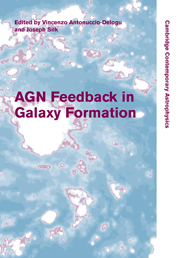Book contents
- Frontmatter
- Contents
- List of contributors
- Preface
- The organising committees
- Part I AGNs, starbursts and galaxy evolution
- Part II Co-evolution of black holes and galaxies
- 5 The symbiosis between galaxies and SMBHs
- 6 On the origin of halo assembly bias
- 7 AGN, downsizing and galaxy bimodality
- Part III Outflows and radio galaxies
- Part IV Models and numerical simulations: methods and results
- Index
6 - On the origin of halo assembly bias
from Part II - Co-evolution of black holes and galaxies
Published online by Cambridge University Press: 10 November 2010
- Frontmatter
- Contents
- List of contributors
- Preface
- The organising committees
- Part I AGNs, starbursts and galaxy evolution
- Part II Co-evolution of black holes and galaxies
- 5 The symbiosis between galaxies and SMBHs
- 6 On the origin of halo assembly bias
- 7 AGN, downsizing and galaxy bimodality
- Part III Outflows and radio galaxies
- Part IV Models and numerical simulations: methods and results
- Index
Summary
Introduction
Halo assembly bias, the dependence of dark-halo clustering on their formation history, is becoming increasingly important. The reason for this is that a better understanding of the formation of galaxies is needed in order to fully exploit new measurements, which are being developed with increasing precision.
According to the standard cosmological scenario, galaxies are formed in high density regions consisting of virialized dark-matter particles. Such systems, termed dark-matter halos, form in a hierarchical and self-similar fashion, in which smaller objects form first and then continuously merge into ever larger objects. The merging process is not linear, in the sense that it doesn't arise from linear theory. Thus, it defines a time-dependent scale in which matter clustering becomes non-linear.
The theoretical framework describing the process of halo formation is the excursion set theory (Bond et al. 1991; Lacey & Cole 1993; Mo & White 1996). According to this theory, dark-matter density fluctuations, at a given scale, grow in the linear regime until they reach a critical value when they collapse. The collapse process is equivalent to a merging process of the smaller scales. When combined with the theory of random Gaussian fields, this framework explains the formation history of halos. A major result is that the history of a halo should not be correlated with the halo environment. This follows because density fluctuations are not correlated with larger scales. Another way of stating this is that halo history should not be correlated with the clustering of the halos themselves.
- Type
- Chapter
- Information
- AGN Feedback in Galaxy Formation , pp. 47 - 51Publisher: Cambridge University PressPrint publication year: 2010

